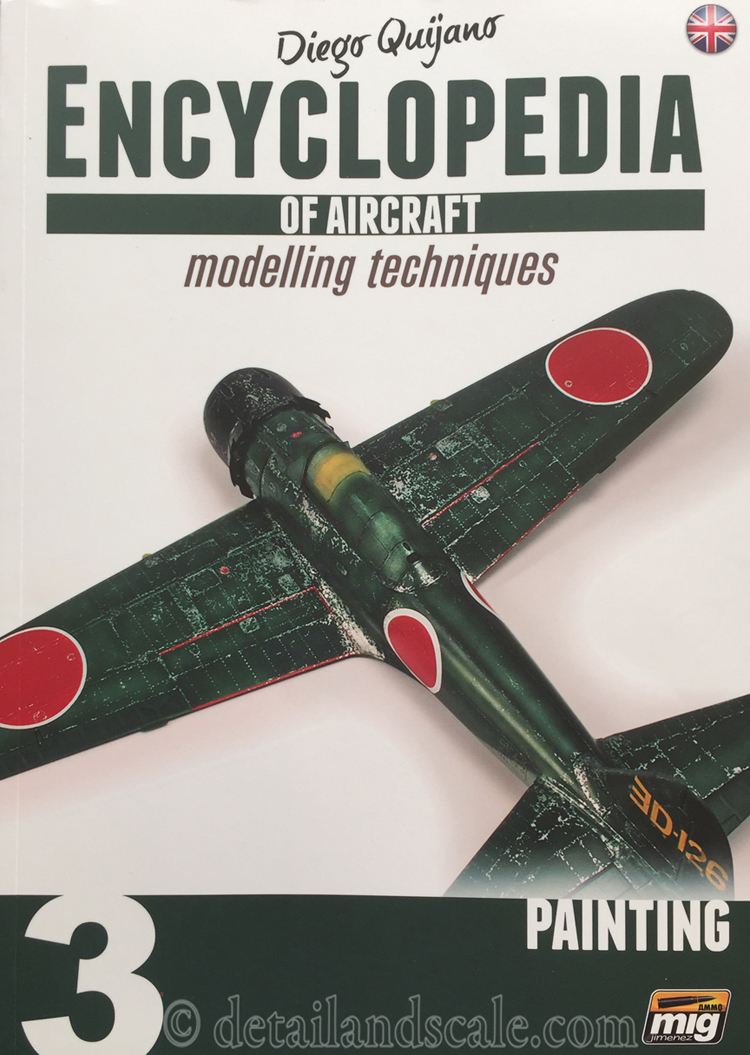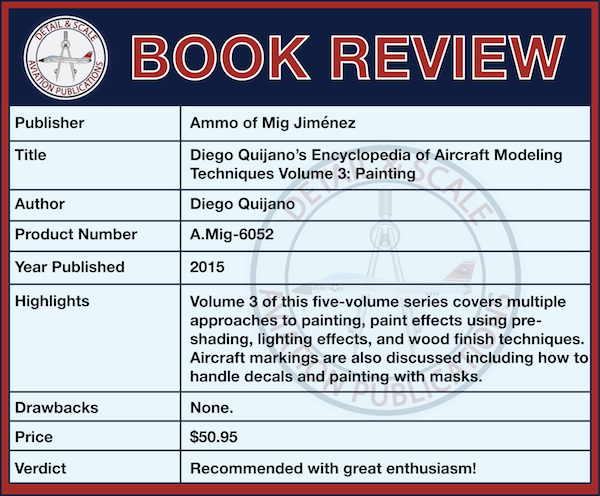Diego Quijano’s Encyclopedia of Aircraft Modeling Techniques Volume 3: Painting
Published by Ammo of Mig Jiménez, 2015



The third installment of Diego Quijano’s five volume modeling techniques encyclopedia picks up where volume 2 left off: painting. This thoroughly illustrated book takes readers through the process of exterior painting and how to carry out multiple approaches to painting, paint effect, and aircraft marking techniques to include decals. Considering that Quijano and his colleagues represent what I call the “Spanish Masterclass” of aircraft painting styles, I’ve been quite eager to read this installment and see how they do it.
Volume 3 maintains the same level of production quality and gets an A+ in this respect. This 199 page-long volume is printed in Spain, and comes in full color on high quality paper. The images are technically flawless and represent some of the best scale model photography out there. And, just as with Volumes 1 and 2, the text is thoughtfully written to speak to novices and advanced modelers alike.
Volume 3: Painting contains several hundred photos and is organized into nine sections: Preparation and Priming, Pre-Shading, Base Coat and Monotone Camouflage Patterns, Multi-Tone Camouflage Patterns, Chipped Camouflage, Airbrush Highlighting and Fading, Wood, Insignia, Numerals and Stencils, and Shading with Inks.
The book starts out with how to prepare scale model surfaces, and highlights the multiple benefits of priming your surfaces (from detecting surface flaws such as those seams you thought you sanded smooth to preventing paint peeling off when masking is removed). Multiple pre-shading techniques are demonstrated, and really demonstrate how and why careful and precise pre-shading techniques can serve to great visual effect. Another tutorial demonstrates why the color of your pre-shading matters in relation to the topcoat, such as how blues under medium grays can really create effective combinations of subtle tonal variation that otherwise would remain out of reach. Other techniques that I had not been familiar with, but that I’m now quite eager to try, are what the author calls “overhead light pre-shading” and “modulated pre-shading” that provide a fuller 3-D depth to tone and color.
Next, the reader is walked through the fundamentals of base coats that include ensuring a smooth finish and how to achieve “overhead light effects” in the basecoat – where a slightly lightened basecoat color is airbrushed on to simulate how certain upper surfaces of an airplane catch overhead light. Smooth gloss base coats are then covered, and metal finishes are discussed next, stressing the role of the all-important gloss-black basecoat and post-shading approaches to metal finishes, since they are not particularly amenable to pre-shading techniques. The example of the IL-2 is particularly impressive and gives readers lots of ideas.
Multiple approaches for camouflage paint schemes are illustrated. These include ways in which to freehand soft edged camouflage schemes, the use of paper masks and blu-tack to achieve semi-hard edges that can be again combined with overhead light effects, and the use of masking tape to paint a convincing hard edge. Doing a good mottled camouflage and ‘snake-line’ camouflage are described next, and a combination of a high dilution ratio, airbrush nozzle size, and airbrushing technique are among the key points underlying a successful paint job.
The section on chipped paint effects held my attention in a rather unique way, particularly owing to the interesting techniques shown to produce very intricate and visually complex results. The most interesting (and new to me) involves the use of an Ammo Mig product called chipping fluid. One begins by painting their surface in an underlying natural metal color (or whatever the desired base color is) and then airbrushing a layer of chipping fluid atop it. Then the top color is sprayed on. The chipping layer provides a temporarily unstable intermediate layer between the top coat and the base coat. As soon as the base coat is dry to the touch, a light application of water activates the chipping fluid. A chipping tool, such as a short-bristled brush or toothpick can then be used to scrub or chip away the top coat. I’ve never used chipping fluid, but seeing the results, as illustrated on a Japanese Zero, a Fw 190, a MiG-3, and a Ju 88 in a winter camouflage scheme are each quite impressive. In other examples, alternate techniques involving sponge chipping and use of colored pencils are illustrated.
Airbrush techniques for lightening and darkening individual aircraft panels can also provide the reader with a range of new techniques to try. A straightforward and well thought-out guide for subtle lightening and darkening of a base color is described, whether it’s a monotone or multicolor camouflage scheme. Another technique new to me is what Quijano calls “modulation” that involves a 3-D lighting effect that consists of a gradated lightening and darkening of panels. The effects are visually striking, but even the author himself concedes that it is an artistic convention and not necessarily scale-accurate. This method and many of the previously described techniques are illustrated on a WWI-era SE. 5 Hisso, and the effect is visually stunning – there’s no debate about that – and represents scale model painting approaching the level of a high art form.
At least for me, the section of Volume 3 that held my attention the most involved how to achieve a realistic wooden finish, such as those seen on WWI aircraft propellers, fuselages, wing struts, and other wood aircraft components. I really want to learn how to do a good wood finish, but for years, but I’ve always been hesitant since many years ago I was told by another scale modeler that it was akin to alchemy. The step-by-step method used to achieve a simulated wood surface shown here in Volume 3 demystifies everything. It is not at all difficult, but I certainly would not have thought these techniques up on my own! The methods used to achieve plywood strip skin, as demonstrated stepwise on a 1:48 scale Sturmovik, is technically speaking not too hard to achieve by one’s self and the results are very effective. For those not into painting simulated wood, working with wood decals (such as from the Uschi Van der Rosten line), are also described, and can be executed with equally stunning results.
Volume 3 is not totally dedicated to painting, and section 5.8 covers application of waterslide decals, dry transfers, and the painting of insignia and other aircraft markings with masks (homemade and commercially available). The section involving the application of decals stresses many tried-and-true techniques, from the importance of having a smooth gloss finish, to the use of decal setting and solvent solutions. Painting roundels or identification numbers with masks can sometimes achieve a far superior result than a decal or dry transfer, and these methods are also illustrated. One of the more creative techniques illustrated here has to be the use of a chipped toothpick as a stamp to simulate airframe stencil markings. The book closes with outlining surface detail with inks and other transparent colors such as Tamiya Smoke. This is something that I’ve never run across, but it seems to work quite effectively. I’ve got to try this to be sure.

I can offer no substantive shortcomings to this volume apart from one tiny editorial error where a small caption was still in the original Spanish and missed getting translated. I speak Spanish, and it wasn’t a problem for me, but for anyone else – you’ll learn that airbrush is an aerografo!

Volume 3 of Diego Quijano’s Encyclopedia of Aircraft Modeling Techniques is just as impressive and valuable as the first two books. It’s filled with excellent techniques and a clear, well-written narrative. These books are indeed pricey, but when you start reading and working with these books, you’ll feel pretty strongly that they are a high-value, high-return investment for scale model aircraft building. Whether you choose to incorporate only some of these painting and marking techniques into your repertoire or if you’re chasing that “Spanish Masterclass” style, Volume 3 will improve your painting game and get your creativity on a roll. Next up: Volume 4 – Weathering.
Many thanks are owed to Mig Jiménez and Iain Hamilton for the review copy of Volume 3. Mil gracias y muchos saludos!
Volume 3 of the Encyclopedia of Aircraft Modeling Techniques is recommended without reservation. You can get a copy at the following sources:
Haagen Klaus
Scale Modeling News & Reviews Editor
Detail & Scale


